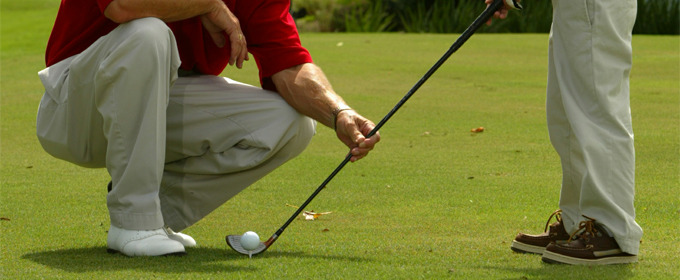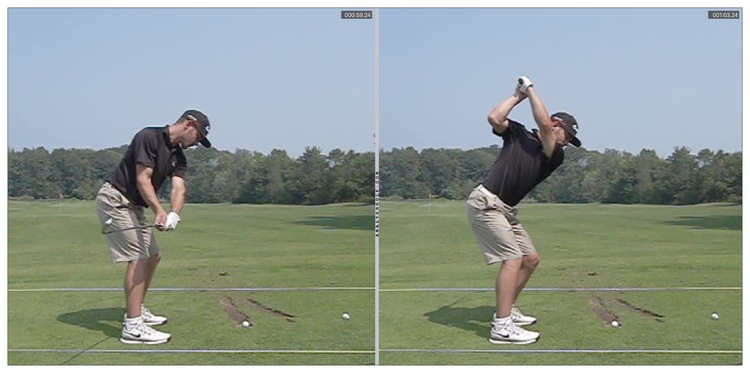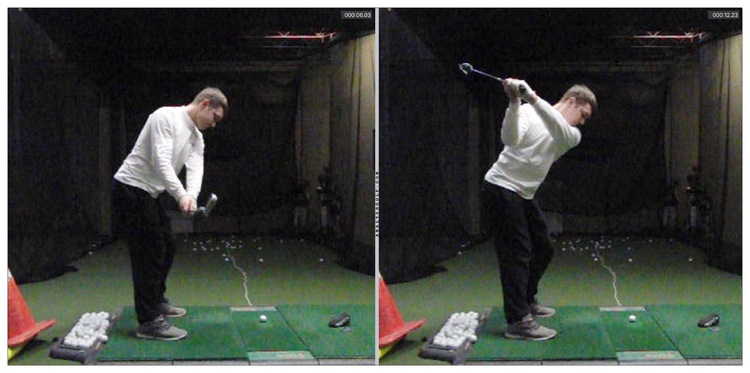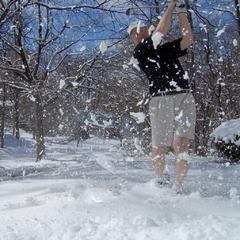I once heard a story of a kid in Florida who practiced his backswing (at the range, with a ball at his feet) for nearly three hours.
Let me say that again with a little added emphasis: he practiced his backswing for nearly three hours.
He didn't hit a single ball. Didn't even make a downswing. He recorded, used a mirror, checked his video, and made backswings for nearly 180 consecutive minutes.
That's madness.
The backswing is an important part of the golf swing. A lot of golfers get off track with the backswing, and then must undergo a series of compensations from there until well after impact to hit the ball anything like they want.
So, often, practicing the backswing is important. It's often a student's priority. For example, this student:
He would roll the clubhead under the plane during the backswing, push it across or over the top of the plane later, and then just swing left from there. The balls were actually landing at the left corner of what's visible in this photo, some 60 yards left of where it appeared he was aiming.
Anyway, that golfer now looks like this in practice:
He, like almost everyone I have practicing backswing things, does what I call the Three-Step Backswing Practice Routine. Okay, I don't call it that; I just made that term up now.
- Make a S-L-O-W rehearsal backswing where you look in a mirror, turn your neck to look at your hands, or whatever you need to do to do it properly (which is often exaggerated). The intent here is to make the swing the way you want to, and see how it feels, and check it right then by looking at whatever body part(s) you need to. Reset in your address position.
- Make a S-L-O-W rehearsal backswing looking at the golf ball. Ask yourself mentally if the backswing was "good." Reset in your address position. If the answer was no, go back to step 1 or repeat step 2. If it was "yes," move on to step 3.
- Make a S-L-O-W rehearsal backswing looking at the golf ball. Ask yourself mentally if the backswing was "good," and then if the answer is "yes," reward yourself by hitting the golf ball. I don't even care much at what speed you hit the golf ball (it depends on your ability to hit it somewhat cleanly so you don't get frustrated).
You see, I found that I could get students to make awesome improvements to their backswing when I said "okay, rehearse, make a good backswing." They'd do it, and it would be perfect. But then if my instruction was to "make that backswing and hit the ball," they'd lose 80%+ of what was good, because their focus shifted dramatically toward "hit the ball."
By breaking it down and making them think "rehearsal backswing, reward if good," it prevents that shift to the golf ball from ever really occurring. Forcing the golfer to ask themselves "was that good?" before being allowed to make a downswing allows them to focus on making the backswing properly without worrying about the golf ball.
And then, most of the time, the student makes a much better downswing because the compensations are minimized or gone. In this case, for example, we didn't spend one second talking about the downswing, and yet…
So remember, three steps to improving your backswing without boring yourself out of your ever-loving mind:
- Make a rehearsal backswing while looking at it and making sure it's good.
- Make a rehearsal backswing while looking at the ball.
- Make a rehearsal backswing and, if you can say "yes" when you ask yourself if it was as good as it was in #1 and #2, hit the ball as a reward.














23 Comments
Recommended Comments
Create an account or sign in to comment
You need to be a member in order to leave a comment
Create an account
Sign up for a new account in our community. It's easy!
Register a new accountSign in
Already have an account? Sign in here.
Sign In Now